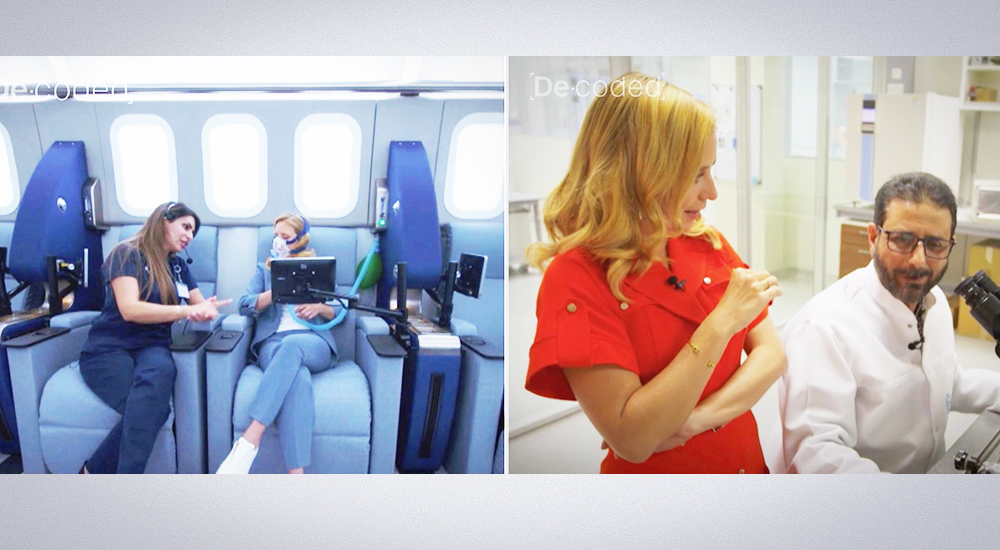CNN’s Decoded highlights the rapid advancements in genetic technologies

In a new episode of Decoded, CNN’s Anna Stewart explores genetic technologies and how they could change the future. From resurrecting extinct species, to eradicating diseases, and from tackling climate change, to living longer, rapid advancements in genomic research are changing our understanding of life.
In 2012, Nobel Prize winning professors Emmanuelle Charpentier and Jennifer Douna made a breakthrough discovery while researching a naturally occurring protein in bacteria called CRISPR-Cas9. Charpentier explains why the discovery was so important for genomic research, “CRISPR-Cas9 works like molecular scissors in a way that can cleave the DNA allowing it to trigger different types of modifications that lead to a change of code in the DNA. Another explanation can be like software that allows us to rewrite text and CRISPR-Cas9 it’s a kind of software that does exactly the same thing on the genomes.”
This discovery opened a world of possibilities, giving scientists the tools to potentially cure genetic diseases and disorders. Francis Collins, Director of the Human Genome Project, tells Stewart, “I was absolutely blown away. This was the kind of game changer that doesn’t come along more than maybe once every decade or maybe more. And if we could figure out how to harness it, this might give hope to those people who suffer from thousands of diseases where we know the DNA mistake, but we don’t have a treatment.”
In Dubai, Stewart meets Dr. Nisar Wani, Scientific Director at the Reproductive Biotechnology Centre, who became the first scientist to clone a camel in 2009. He teaches Stewart how to extract DNA and she attempts the process of cloning. Alongside camel cloning, Dr. Wani says that he is building up a gene bank to preserve other animals and endangered species which he believes will stop species going extinct.
As well as preventing extinction, genetic technologies could be used to revive lost species. Colossal Biosciences are hoping to bring back the woolly mammoth by 2027, using the DNA from mammoth remains that have been frozen in permafrost for thousands of years. Colossal CEO and co-founder Ben Lamm says that the project would be good for rewilding and for decelerating the effects of climate change, “Just because you can do it doesn’t mean you should, you need to be very thoughtful and cautious about any rewilding, whether it’s an extinct species, a critically endangered species or a species that was previously located in that region that no longer exists there.”
Dr. Tarifa Al Zaabi, Director General at the International Center for Biosaline Agriculture (ICBA), tells the programme that genomic research could be used to solve world hunger. The ICBA is finding ways to grow food in arid environments, sequencing the genomes of crops and identifying traits that can lead to healthier, more nutritious and resilient produce.
Critics argue that the effects of gene-editing are not yet fully understood and raise concerns about the ethics of manipulating nature at such a large scale. Maddie Hall, CEO & Co-Founder, Living Carbon, believes that the positives outweigh the negatives, “We’ve been mucking around with nature for a really long time as humans. That’s gotten us into this mess, right? This is a problem we’ve created, right? And even though we’ve seen large scale warming and cooling across geological time, the rate in which this is happening is much faster than ever before. So I think it’s actually irresponsible to not use all these tools at our disposal that could potentially help our ecosystems actually survive the problem that we’ve created.”
Genetic technologies can also be used to unlock the science of aging. David Sinclair, Professor of Genetics at Harvard Medical School describes the push to reverse aging, “I didn’t know in my career that we would be able to do this. I thought we’d just be able to slow down aging and that was good enough. It turns out if you turn on genes that are normally only turned on in embryos and if we put them into adult animals we can actually reverse their age in a matter of just a couple of months. We don’t fully understand how it works yet. But what I can tell you, for sure, is that in an old mouse and probably in an old person, the information to be young again still exists. We just need to know how to flip the switch and reinstall that software to be young again.”
Rapid advancements in genomics are revolutionising our world and deepening our understand of life. By further developing these technologies, scientists around the world think that we can save species, fight against climate change, and cure diseases.
Credit : CNN




